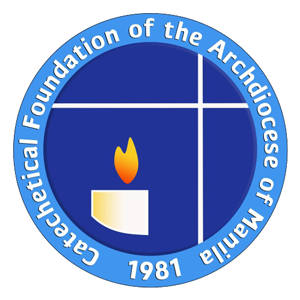ANONG ORAS NA SA BUHAY MO?
The month of November has always been a tradition for CFAM to remember our beloved catechists who have gone before us. Before we are allowed to enter the Layforce Chapel, we were given time to offer flowers and prayers to the departed catechists.
The program started with a morning prayer followed by a eucharistic celebration presided over by Fr. Carlo Magno Marcelo. The gathering is not complete without the talk of the minister, which was an updated version of the talk “The Two Halves of Life.”
Our life is a movement, as stated by Fr. Carlo. The first half of our life is going up or the path of ascent. While the second half of our life is going down, the path of descent. There is no chronological age but for easy understanding, we give a probable chronological age like in midlife which can happen between 40 to 65 years old and starts with the weakening of the body. However, as the physical strength lowers down, the spiritual experience rises up. The person becomes spiritually mature.
The task of the first half is individuation wherein our experience of ourselves is insubstantial. To become substantial, one has to deal with the substantiality of the world. The reason why depression can easily come in.
Fr. Carlo reminded us that we need not tell the youth to express themselves, because they do not yet have a concept of themselves. We have to teach them to develop their skills, personalities and talents in order for them to better know their selves. Rules and laws are needed to build up the self.
In the first half of life, parents cannot be best friends with their children but fathers and mothers to them because they already have lots of friends. What they need are a father and a mother. We have to help them reach the point of…“Ito ako” to be able to answer the question “Sino ako?”
By puberty, we are as if driven out of our homes. We look outside of our homes for companionship, for activities and for success.
The song “Dito Ba?” sung by Kuh Ledesma was played in reference to our midlife crisis situation. That at a certain point in life, success will lose its meaning. The meaning that cannot already be seen in the drive for success.
According to Fr Carlo, traditions are important to help the youth as they grow because in life there came paradoxes (kabalintunaan). We need to prepare them for the paradoxes of life to avoid depression.
Fr. Carlo stressed that midlife is a central period of a person’s life spanning from approximately age 40 to 65. It can be a stressful time as many people come to feel discontented and restless as they struggle with aging, mortality and holding on to a sense of purpose.
There are six (6) stages of midlife crisis that we have to be aware of.
- Denial 4. Depression
- Anger 5. Withdrawal
- Replay 6. Acceptance
Symptoms of a midlife crisis:
- Feeling sad or lack of confidence, especially after a big milestone accomplishment or birthday
- Felling bored, loss of meaning or purpose in life
- Feeling unfulfilled
- Feelings of nostalgia
- Excessively thinking about the past
- Making impulse actions
- Feelings of regret
- Constantly comparing yourself to others
- In women, these symptoms may be made worse because of menopause
- In men, emotions may be more angry or irritated.
The consolation in midlife crisis is that the spirit soars, it matures.
Fr. Carlo reminded us that, the spirituality in the first half is that the effort is centered on adapting to the surrounding world. Our life is fashioned by the outside world, we develop our persona, characterized by our achievements and we are named by the world around us.
In the second half of life, our task is transcendence. Looking for the meaning of life, we go beyond one’s self. A major shift happens physically, psychologically and spiritually. The questions about the purpose and meaning of life emerge. Program of life shifts to finding one’s true identity as one is confronted with the reality of changes that occur from midlife onward. The major task is the integration of these necessary changes.
In the first half of life, we are taught of dualism. One distinguishes himself from the other. That is why we train children to distinguish good and evil, clean and unclean, fair and unfair, just and unjust, rich and poor and reward and punishment.
The second half of life leads us to unifying. So, the work of the second half of life begins seeking a new spirituality, perhaps a new encounter with God that helps to begin to make sense of life as lived. It doesn’t do away with the container from the first half of life but it makes sense differently of the dualism. The experience of God changes from that of a keeper of dualisms to that of a unifier.
Above all, in the second half of life, we come to experience life as neither fair nor unfair. Life simply is. It is what it is. And when we are most fortunate, that “isness” is grace…a gift.
The talk was concluded by a group sharing, reflecting on the question “Anong oras na sa buhay mo?”




